-
Paper Information
- Next Paper
- Paper Submission
-
Journal Information
- About This Journal
- Editorial Board
- Current Issue
- Archive
- Author Guidelines
- Contact Us
Algorithms Research
p-ISSN: 2324-9978 e-ISSN: 2324-996X
2013; 2(1): 1-7
doi:10.5923/j.algorithms.20130201.01
Implementation of Low Cost Ethernet Based Home Security Using Wireless Sensor Network
B. Udaya Kumar1, D. S. Murty2, Ch. R. Phani Kumar3
1Department of EIE, GITAM University, Visakhapatnam
2GVP School of Engineering Technical campus, Visakhapatnam
3Department of ECE, GITAM University, Visakhapatnam
Correspondence to: B. Udaya Kumar, Department of EIE, GITAM University, Visakhapatnam.
| Email: |  |
Copyright © 2012 Scientific & Academic Publishing. All Rights Reserved.
Wireless technologies have been popular and rapidly developed during couple of years which are being used in smart applications like home automation, greenhouse monitoring, healthcare and industrial control etc. The increasing demand in home security has become one of the most essential requirements, both in anti-theft perspective and in anti-accident perspective. Home security systems are available with fixed cameras interfaced through wires to a dedicated PC with internet for accessing the data from remote location. This paper presents the implementation of a low cost wireless home security system using zigbee protocol and remote access through internet. A ZigBee based star network with two nodes had been established employing Xbee radio, ARM7, PIC, and MBED microcontroller. The detection of the intruder motion, gas leakage detection and visual surveillance of the home were provided with the help of Passive Infrared Sensor (PIR), Gas sensor (GH-312) and Camera (LS_Y201).The data transmitted from the nodes using ZigBee modules has been received through on chip Ethernet of MBED microcontroller. The complete design of hardware for each of the nodes has been presented. The implementation of the hardware has been successfully tested for its validation. The performance of the system found to be satisfactory and the results are presented in this paper. The data acquisition of the designed hardware system has been remotely accessed with the help of web server
Keywords: ZigBee, Wireless Sensor Network, Mbed, ARM7, PIR Sensor, Low Cost Design
Cite this paper: B. Udaya Kumar, D. S. Murty, Ch. R. Phani Kumar, Implementation of Low Cost Ethernet Based Home Security Using Wireless Sensor Network, Algorithms Research, Vol. 2 No. 1, 2013, pp. 1-7. doi: 10.5923/j.algorithms.20130201.01.
Article Outline
1. Introduction
- In recent years the need for smart home security has been increasing to protect the wealth of the people. Many Home automation techniques are already available to reduce the system complexity and lower fiscal costs. It was described about a system that endeavors not to incorporate complex and expensive components, such as a High end personal computer, where possible. The system is flexible and scalable, allowing additional home appliances designed by multiple vendors, to be securely and safely added to the home network with the minimum amount of effort. The system allows home owners to monitor and control connected devices in the home, through a variety of controls, including a ZigBee based remote control, and any Wi-Fi enabled device which supports Java. Additionally, users may remotely monitor and control their home devices using any Internet enabled device with Java support. A home gateway is implemented to facilitate interoperability between heterogeneous networks and provide a consistent interface, regardless of the accessing device[1]. It was proposed that a ZigBee-based integrated remote control scheme which constructs the home networking system and controls all electric appliances in the house without additional design changes. This also includes a ZigBee-based power adapter scheme to connect home appliance which has no communication devices. Moreover, it implements a prototype system to show that the proposed system is one the practical solutions for controlling electric appliances in the home automation system[2]. It was designed and implemented a ZigBee based intelligent self-adjusting sensor (ZiSAS) for home energy management service considering these limited characteristics of sensors. This system has distinct features like flexible three layered middleware architecture, Situation based self-adjusting: that can autonomously reconfigure middleware, network topology, sensor density, and sensing rate based on the environmental situation, Event based sensor control, Context-aware service: The system continuously gathers environmental Information and analyzes the current situations to provide the residents with context-aware services work[3]. A different method was proposed about a wide variety of use cases and main feature of WHANs[4]. A development and characterization of a surveillance robot with hopping capabilities for home security is presented[5]. In 1975 Home automation had been done through X.10 protocol which uses power line carrier communication for controlling the devices. The Bluetooth controlled appliances with remote access through internet also exists. Now ZigBee is being currently used in Home automation for its advantages over Bluetooth. ZigBee is an open and global standard protocol for low data rate personal area network. The low power, ad hoc and self healing characteristics makes ZigBee more advantageous in home automation. A ZigBee protocol based network consists of three devices viz Coordinator, Router, and an End device (ED). The coordinator is the first device on the network and responsible for establishing the network. End devices are interfaced to the sensors, acquire the data and send this information to the coordinator. The Router helps in forwarding of the data of its own and end devices when the end devices are not in the vicinity of the coordinator[6]. The objective of the work is to implement a low cost home security system, is to replace the dedicated PC with internet by an on –chip Ethernet embedded controller and also fixed camera’s are replaced with the movable camera’s.
2. System Design
- The Figure 1 shows block diagram of the proposed home security system. The system was implemented with a star network topology consisting of two nodes. One node is used for the detection of motion of the intruder, detection of gas leakage and other is to capture the image of the intruder. The data acquired from the nodes are transmitted wirelessly using ZigBee protocol to the base station. The data collected at the base station is kept on the web server for accessing the data through internet from anywhere.
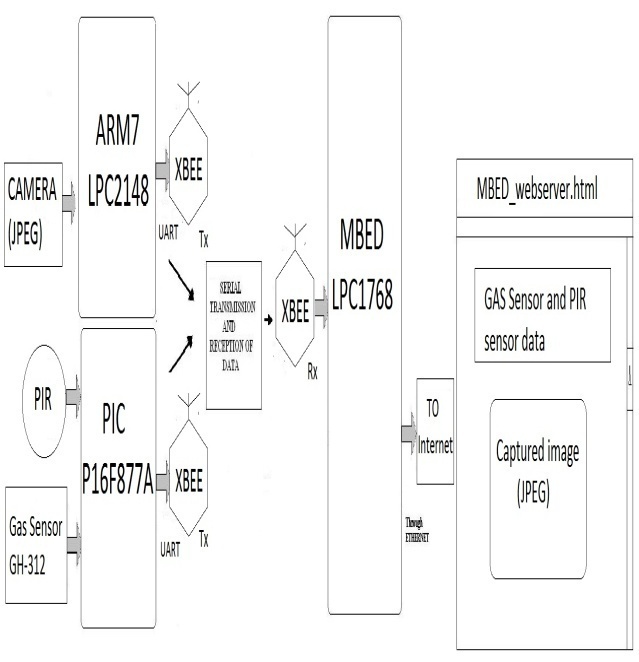 | Figure 1. Block Diagram of Home Security System |
3. Hardware System Design
- The hardware design modules designed using various hardware components are presented in detail. Figures 2, 3 and 4 shows the hardware modules developed for the home security system. There are three modules 1)PIR sensor for sensing the intruder motion 2)Gas sensor(GH-312) for detection of the leakage of the LPG gas 3)camera is used for the capturing the image of the intruder.
3.1. Intruder Motion and Gas Sensing Node (ED1)
- The Figure 2 shows the module developed to sense the presence of the intruder and leakage of the gas. The PIC16F877A microcontroller was interfaced to the PIR sensor and GH-312 gas detection sensor. The UART of the PIC was interfaced to Xbee transceiver and configured as an end device. The sensor node acquires the data from PIR, gas sensors and placed in the memory of the microcontroller. This data will be transmitted to the base station on ITS request. The PIR sensor detects the motion of the humans by sensing the radiation emitted by the humans. The sensor produces the digital output at the instance of human motion. This sensor is interfaced to the PORTB.1 of PIC16F877A.The Gas sensor gives the analog output voltage based on the intensity of the gas. This sensor is interfaced to the analog port of PIC RA0.The PIC16F877A has on chip 10-bit ADC converts the voltage from gas sensor and stores in the flash memory of the microcontroller.
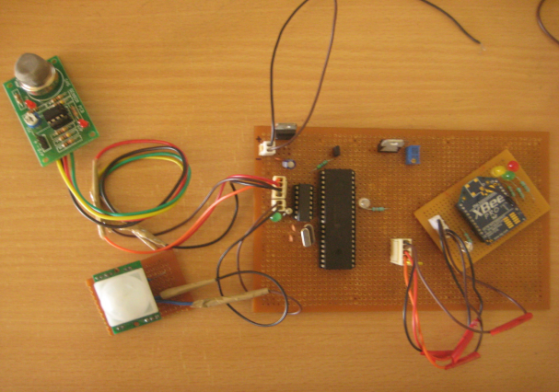 | Figure 2. Sensor node for redetection of Intruder and Gas leakage |
3.2. Image Acquisition node (ED2)
- The Figure 3 shows the module developed to acquire the image of the intruder. To interface a camera and Xbee to the microcontroller, two UART’s are required but PIC16F877A microcontroller has only one UART hence LPC2148 ARM7 microcontroller was chosen because it has UART’s and larger memory (4GB) to store the picture information. The JPEG Camera LS_Y201 is interfaced to the LPC2148 microcontroller through one of the UART port’s. The other UART of the LPC2148 microcontroller was interfaced to the Xbee transceiver. This sensor module was configured as an end device and acquires the images and store’s it in SD-card memory, transmits the data to the base station when requested.
3.3. Base Station
- The Figure 4 shows the base station, developed with the MBED CORTEX-M3 (LPC1768) microcontroller operates at a clock frequency of 800MHz. The MBED microcontroller UART is interfaced to Xbee and has on-chip Ethernet. The information received from the PIR, Gas and Camera nodes are placed in the SD card and will be sending to the MBED web server through on- chip Ethernet.
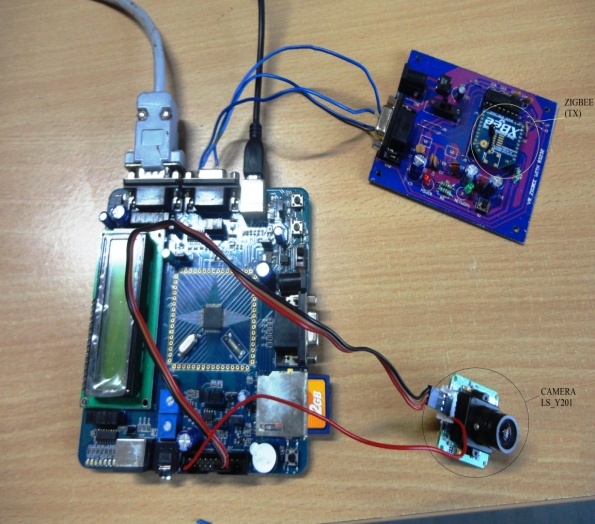 | Figure 3. Sensor Node with Camera for image acquisition |
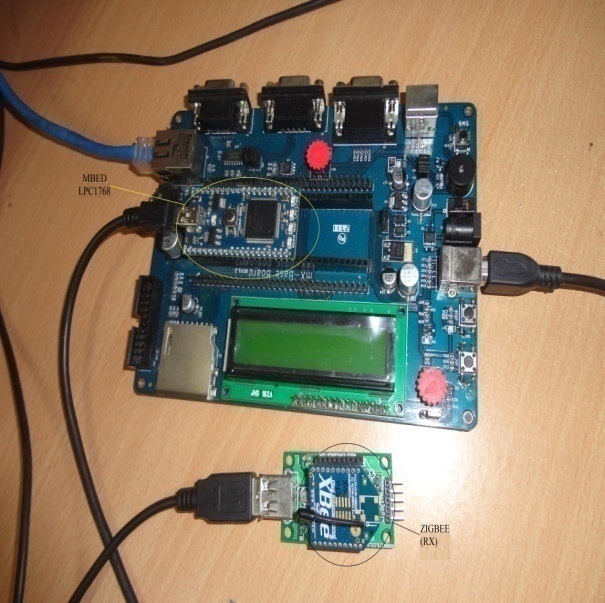 | Figure 4. Base Station |
4. Software System Design
- The flow charts of data acquisition from PIR and Gas sensor module is given in Figure 5, image acquisition is given in Figure 6, and Base Station is given in Figure 7. The IDE’s used to program the modules in this work are mikroC for programming PIC microcontroller, Keil uVision4 for LPC2148 and online C++ compiler for MBED LPC1768 microcontroller[7]. The X-CTU software is used to configure Xbee transceivers as coordinator, and end devices. The Figure 8 shows the configuration of Xbee as coordinator.
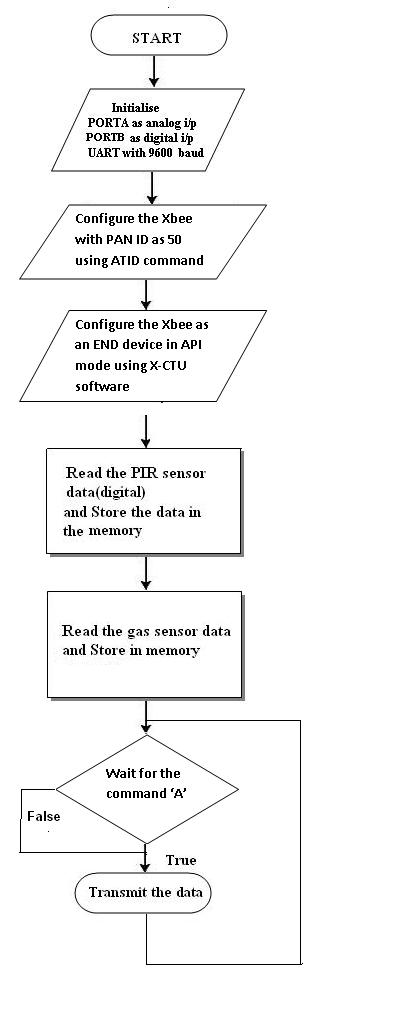 | Figure 5. PIR and Gas sensor flow chart |
 | Figure 6. Image Acquisition Sensor Node flow chart |
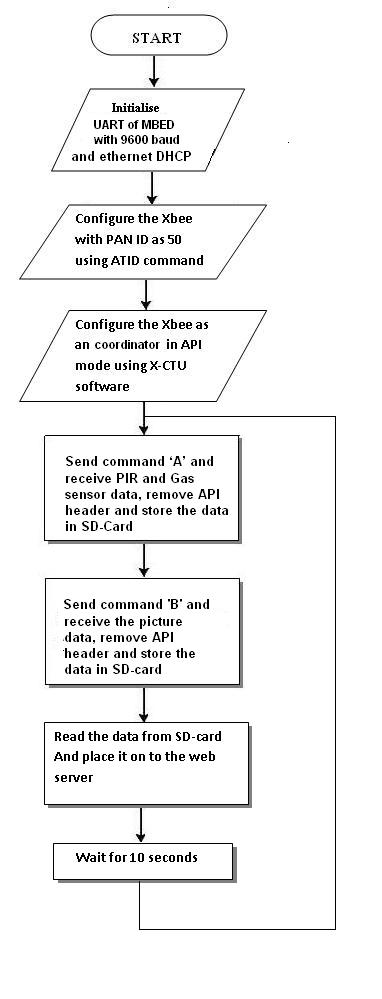 | Figure 7. Base Station flow chart |
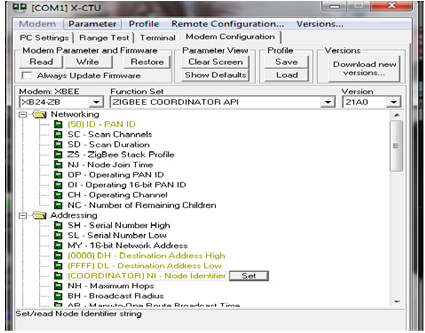 | Figure 8. Configuration of xbee radio |
 | Figure 9. Data transferred from Gas sensor to base station |
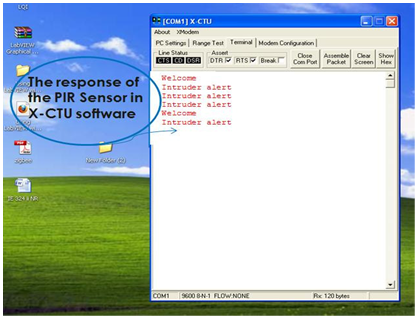 | Figure 10. PIR sensor data |
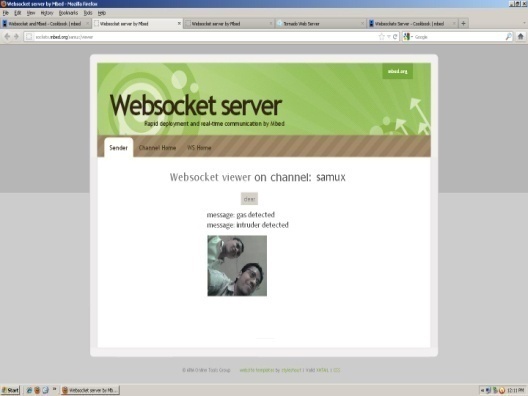 | Figure 11. Data on the web server |
5. RESULTS
- The Figure 9 shows the data collected from the motion sensor and Figure 10 shows the data received from the PIR sensor. The image has been successfully captured and placed on the web server shown in figure 11. A portable home security system was successfully designed and tested, where the role of PC is eliminated for sending the data. It is portable and low cost solution for the home security.
 Abstract
Abstract Reference
Reference Full-Text PDF
Full-Text PDF Full-text HTML
Full-text HTML